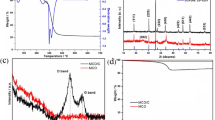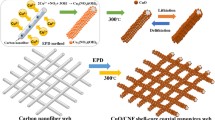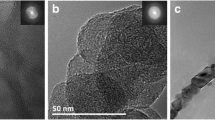Abstract
Improving the electron/ion transport ability and alleviating expansion during charging/discharging processes are vital for lithium-ion batteries (LIBs). In this work, a three-dimensional anode was fabricated using conductive hollow carbon-based nanotubes interpenetrated MXene architecture by directing the assembly of flexible electrospun hollow copper/carbon nanotubes and rigid Ti3C2Tx MXene nanosheets. The introduction of copper into carbon matrix leads to an improvement of lithium storage owing to the increase of disorder graphite. Additionally, the unique structure of the fabricated electrode provides a cross-network for fast electron diffusion by preventing the stack of nanotubes and MXene nanosheets. Consequently, the optimized electrode exhibits a high initial capacity of 424.45 mAh·g−1 and maintains at 378.05 mAh·g−1 with a current density of 5 A·g−1 after 1000 cycles. This strategy of structural and chemical optimization provides new ideas for developing high-performance and durable electrochemical energy storage devices in the future.
Graphic abstract

摘要
提升电子/离子传输能力以及缓解充放电过程中的体积膨胀对锂离子电池至关重要。本工作选用柔性电纺中空Cu掺杂碳纳米纤维与刚性Ti3C2Tx MXene纳米片作为构筑单元, 制备了具有穿插三维结构的锂离子电池负极材料。该材料碳骨架中Cu的引入使碳的无序度增加, 从而提高了锂的存储能力。此外, 独特穿插三维结构为电子的快速传输提供了交叉立体网络, 并避免了中空纳米纤维与MXene纳米片的堆叠, 从而改善电子和离子传输速率。因此, 该材料作为锂离子电池负极, 具有较高的初始比容量424.45 mAh·g–1, 并且在5 A·g–1的电流密度下, 循环1000次后仍保持378.05 mAh·g–1的比容量。该结构和化学优化策略为未来开发高性能电化学能量储存器件提供了新的思路。





Similar content being viewed by others
References
Yoshino A. The birth of the lithium-ion battery. Angew Chem Int Edit. 2012;51(24):5798. https://doi.org/10.1002/anie.201105006.
Yang XX, Zhang GJ, Bai BS, Li Y, Li YX, Yang Y, Jian X, Wang XW. Fluorinated graphite nanosheets for ultrahigh-capacity lithium primary batteries. Rare Met. 2021;40(7):1708. https://doi.org/10.1007/s12598-020-01692-y.
Zhang YS, Schneider K, Qiu H, Zhu HL. A perspective of low carbon lithium-ion battery recycling technology. Carbon Capture Sci Technol. 2022;5:100074. https://doi.org/10.1016/j.ccst.2022.100074.
Wei CH, Guo SG, Ma W, Mei SX, Xiang B, Gao B. Recent progress of bismuth-based electrode materials for advanced sodium ion batteries anode. Chin J Rare Met. 2021;45(5):611. https://doi.org/10.13373/j.cnki.cjrm.XY20070021.
Li M, Lu J, Chen ZW, Amine K. 30 years of lithium-ion batteries. Adv Mater. 2018;30(33):1800561. https://doi.org/10.1002/adma.201800561.
Xu WX, Zhao X, Tang JL, Zhang C, Gao Y, Sasaki S, Tamiaki H, Li A, Wang XF. Synthesis of Chl@Ti3C2 composites as an anode material for lithium. Front Chem Sci Eng. 2021;15:709. https://doi.org/10.1007/s11705-020-1984-z.
Wang YS, Zhang QL, Jia M, Yang DP, Wang JJ, Li M, Zhang J, Sun Q, Jia Y. Porous graphene for high capacity lithium ion battery anode material. Appl Surf Sci. 2016;363:318. https://doi.org/10.1016/j.apsusc.2015.11.264.
Kang C, Lahiri I, Baskaran R, Kim WG, Sun YK, Choi W. 3-dimensional carbon nanotube for Li-ion battery anode. J Power Sources. 2012;219:364. https://doi.org/10.1016/j.jpowsour.2012.07.050.
Tokumitsu K, Fujimoto H, Mabuchi A, Kasuh T. High capacity carbon anode for Li-ion battery: a theoretical explanation. Carbon. 1999;37(10):1599. https://doi.org/10.1016/S0008-6223(99)00031-7.
Guo YM, Zhang LJ, XiLi D, Kang J. Advances of carbon materials as loaders for transition metal oxygen/sulfide anode materials. Chin J Rare Metals. 2021;45(10):1241. https://doi.org/10.13373/j.cnki.cjrm.XY20040016.
Dai HH, Zhao X, Xu H, Yang J, Zhou JY, Chen Q, Sun GZ. Design of vertically aligned two-dimensional heterostructures of rigid Ti3C2TX MXene and pliable vanadium pentoxide for efficient lithium ion storage. ACS Nano. 2022;16(4):5556. https://doi.org/10.1021/acsnano.1c10212.
Wang JT, Chen PP, Shi BB, Guo WW, Jaroniec M, Qiao SZ. A regularly channeled lamellar membrane for unparalleled water and organics permeation. Angew Chem Int Edit. 2018;57(23):6814. https://doi.org/10.1002/anie.201801094.
Li DM, Li HT, Zheng SM, Gao N, Li S, Liu J, Hou LL, Liu JC, Miao BB, Bai J, Cui ZM, Wang N, Wang B, Zhao Y. CoS2-TiO2@C core-shell fibers as cathode host material for high-performance lithium-sulfur batteries. J Colloid Interf Sci. 2022;607:655. https://doi.org/10.1016/j.jcis.2021.08.171.
Zhao Y, Cao XY, Jiang L. Bio-mimic multichannel microtubes by a facile method. J Am Chem Soc. 2007;129(4):764. https://doi.org/10.1021/ja068165g.
Wu DC, Li ZH, Zhong MJ, Kowalewski T, Matyjaszewski K. Templated ynthesis of nitrogen-enriched nanoporous carbon materials from porogenic organic precursors prepared by ATRP. Angew Chem Int Edit. 2014;53(15):3957. https://doi.org/10.1002/anie.201309836.
Zhao XX, Wang JY, Yu RB, Wang D. Construction of multishelled binary metal oxides via coabsorption of positive and negative ions as a superior cathode for sodium-ion batteries. J Am Chem Soc. 2018;140(49):17114. https://doi.org/10.1021/jacs.8b09241.
Ding L, Wei YY, Li LB, Zhang T, Wang HH, Xue J, Ding LX, Wang SQ, Caro J, Gogotsi Y. MXene molecular sieving membranes for highly efficient gas separation. Nat Commun. 2018;9:155. https://doi.org/10.1038/s41467-017-02529-6.
Wang XF, Qian YM, Wang LN, Yang H, Li HL, Zhao Y, Liu TX. Sulfurized polyacrylonitrile cathodes with high compatibility in both ether and carbonate electrolytes for ultrastable lithium-sulfur batteries. Adv Funct Mater. 2019;29(39):1902929. https://doi.org/10.1002/adfm.201902929.
Saleh TA, Al-Shalalfeh MM, Al-Saadi AA. Silver loaded graphene as a substrate for sensing 2-thiouracil using surface-enhanced Raman scattering. Sensor Actuat B-Chem. 2018;254:1110. https://doi.org/10.1016/j.snb.2017.07.179.
Hong ZS, Zhen YC, Ruan YR, Kang ML, Zhou KQ, Zhang JM, Huang ZG, Wei MD. Rational design and general synthesis of S-doped hard carbon with tunable doping sites toward excellent Na-ion storage performance. Adv Mater. 2018;30(29):1802035. https://doi.org/10.1002/adma.201802035.
Sun XZ, Wang CL, Gong Y, Gu L, Chen QW, Yu Y. A flexible sulfur-enriched nitrogen doped multichannel hollow carbon nanofibers film for high performance sodium storage. Small. 2018;14(35):1802218. https://doi.org/10.1002/smll.201802218.
Liu JC, Wang N, Yu LJ, Karton A, Li W, Zhang WX, Guo FY, Hou LL, Cheng QF, Jiang L, David WA, Zhao Y. Bioinspired graphene membrane with temperature tunable channels for water gating and molecular separation. Nat Commun. 2017;8:2011. https://doi.org/10.1038/s41467-017-02198-5.
Zhang Z, Huang Y, Liu XD, Chen C, Xu Z, Liu PB. Zeolitic imidazolate frameworks derived ZnS/Co3S4 composite nanoparticles doping on polyhedral carbon framework for efficient lithium/sodium storage anode materials. Carbon. 2020;157:244. https://doi.org/10.1016/j.carbon.2019.10.052.
Huang SF, Li ZP, Wang B, Zhang JJ, Peng ZQ, Qi RJ, Wang J, Zhao YF. N-doping and defective nanographitic domain coupled hard carbon nanoshells for high performance lithium/sodium storage. Adv Funct Mater. 2018;28(10):1706294. https://doi.org/10.1002/adfm.201706294.
Pan F, Yu LZ, Xiang Z, Liu ZC, Deng BW, Cui EB, Shi Z, Li X, Lu W. Improved synergistic effect for achieving ultrathin microwave absorber of 1D Co nanochains/2D carbide MXene nanocomposite. Carbon. 2021;172:506. https://doi.org/10.1016/j.carbon.2020.10.039.
Tian Y, An YL, Liu CK, Xiong SL, Feng JK, Qian YT. Reversible zinc-based anodes enabled by zincophilic antimony engineered MXene for stable and dendrite-free aqueous zinc batteries. Energy Storage Mater. 2021;41:343. https://doi.org/10.1016/j.ensm.2021.06.019.
Li ZK, Wei YY, Gao X, Ding L, Lu Z, Deng JJ, Yang XF, Caro J, Wang HH. Antibiotics separation with MXene membranes based on regularly stacked high-aspect-ratio nanosheets. Angew Chem Int Edit. 2020;59(24):9751. https://doi.org/10.1002/anie.202002935.
Cheng RF, Hu T, Zhang H, Wang CM, Hu MM, Yang JX, Cui C, Guang TJ, Li CJ, Shi C, Hou PX, Wang XH. Understanding the lithium storage mechanism of Ti3C2Tx MXene. J Phys Chem C. 2019;123(2):1099. https://doi.org/10.1021/acs.jpcc.8b10790.
Landi BJ, Ganter MJ, Cress CD, DiLeo RA, Raffaelle RP. Carbon nanotubes for lithium ion batteries. Energy Environ Sci. 2009;2(6):638. https://doi.org/10.1039/B904116H.
Ma LL, Yu LJ, Liu JC, Su YQ, Li S, Zang XH, Meng T, Zhang SH, Song JJ, Wang JY, Zhao XX, Cui ZM, Wang N, Zhao Y. Construction of Ti4O7/TiN/carbon microdisk sulfur host with strong polar N-Ti–O bond for ultralong life lithium–sulfur battery. Energy Storage Mater. 2022;44:180. https://doi.org/10.1016/j.ensm.2021.09.024.
Han XG, Sun LM, Wang F, Sun D. MOF-derived honeycomb-like N-doped carbon structures assembled from mesoporous nanosheets with superior performance in lithium-ion batteries. J Mater Chem A. 2018;6(39):18891. https://doi.org/10.1039/C8TA07682K.
Li Z, Wang C, Chen XZ, Wang XX, Li XY, Yamauchi Y, Xu XJ, Wang J, Lin CF, Luo D, Wang XF, Zhao XS. MoOx nanoparticles anchored on N-doped porous carbon as Li-ion battery electrode. Chem Eng J. 2020;381:122588. https://doi.org/10.1016/j.cej.2019.122588.
Zheng ZM, Zhang X, Pei F, Dai Y, Fang XL, Wang TL, Zheng NF. Hierarchical porous carbon microrods composed of vertically aligned graphene-like nanosheets for Li-ion batteries. J Mater Chem A. 2015;3(39):19800. https://doi.org/10.1039/C5TA05183E.
Xu CP, Niu DC, Zheng N, Yu HN, He JP, Li YS. Facile synthesis of nitrogen-doped double-shelled hollow mesoporous carbon nanospheres as high-performance anode materials for lithium ion batteries. ACS Sustai Chem Eng. 2018;6(5):5999. https://doi.org/10.1021/acssuschemeng.7b04617.
Gao C, Feng JZ, Dai JR, Pan YY, Zhu YL, Wang WH, Dong YF, Cao LF, Guan L, Pan L, Hu H, Wu MB. Manipulation of interlayer spacing and surface charge of carbon nanosheets for robust lithium/sodium storage. Carbon. 2019;153:372. https://doi.org/10.1016/j.carbon.2019.07.047.
Wang W, Sun Y, Liu B, Wang SG, Cao MH. Porous carbon nanofiber webs derived from bacterial cellulose as an anode for high performance lithium ion batteries. Carbon. 2015;91:56. https://doi.org/10.1016/j.carbon.2015.04.041.
Chen M, Yu C, Liu SH, Fan XM, Zhao CT, Zhang X, Qiu JS. Micro-sized porous carbon spheres with ultra-high rate capability for lithium storage. Nanoscale. 2015;7(5):1791. https://doi.org/10.1039/C4NR05878J.
Wang JY, Tang HJ, Wang H, Yu RB, Wang D. Multi-shelled hollow micro-/nanostructures: promising platforms for lithium-ion batteries. Mater Chem Front. 2017;1(3):414. https://doi.org/10.1039/C6QM00273K.
Liang XH, Ou X, Zheng FH, Pan QC, Xiong XH, Hu RZ, Yang CH, Liu ML. Surface modification of Na3V2(PO4)3 by nitrogen and sulfur dual-doped carbon layer with advanced sodium storage property. ACS Appl Mater Interfaces. 2017;9(15):13151. https://doi.org/10.1021/acsami.7b00818.
Rajagopalan R, Zhang L, Dou SX, Liu HK. Lyophilized 3D lithium vanadium phosphate/reduced graphene oxide electrodes for super stable lithium ion batteries. Adv Energy Mater. 2016;6(1):1501760. https://doi.org/10.1002/aenm.201501760.
Acknowledgements
This study was financially supported by the National Natural Science Foundation of China (Nos. 22005012 and 22105059), the Talent Introduction Program of Hebei Agricultural University (No. YJ201810), the Youth Top-notch Talent Foundation of Hebei Provincial Universities (No. BJK2022023) and Self-deployed Projects of Ganjiang Innovation Academy, Chinese Academy of Sciences. This work was also funded by the Natural Science Foundation of Hebei Province (No. B2019204009). The work is supported by Key Laboratory of Intelligent Textile and Flexible Interconnection of Zhejiang Province (No. ZD05). J. Liu acknowledges the Interdisciplinary Research Project for Young Teachers of USTB (No. FRF-IDRY-21-015) and the Fundamental Research Funds for the Central Universities of USTB.
Author information
Authors and Affiliations
Corresponding authors
Ethics declarations
Conflict of interests
The authors declare that they have no conflict of interest.
Supplementary Information
Below is the link to the electronic supplementary material.
Rights and permissions
Springer Nature or its licensor (e.g. a society or other partner) holds exclusive rights to this article under a publishing agreement with the author(s) or other rightsholder(s); author self-archiving of the accepted manuscript version of this article is solely governed by the terms of such publishing agreement and applicable law.
About this article
Cite this article
Liu, JC., Ma, LL., Li, S. et al. Three-dimensional architecture using hollow Cu/C nanofiber interpenetrated with MXenes for high-rate lithium-ion batteries. Rare Met. 42, 3378–3386 (2023). https://doi.org/10.1007/s12598-023-02372-3
Received:
Revised:
Accepted:
Published:
Issue Date:
DOI: https://doi.org/10.1007/s12598-023-02372-3




